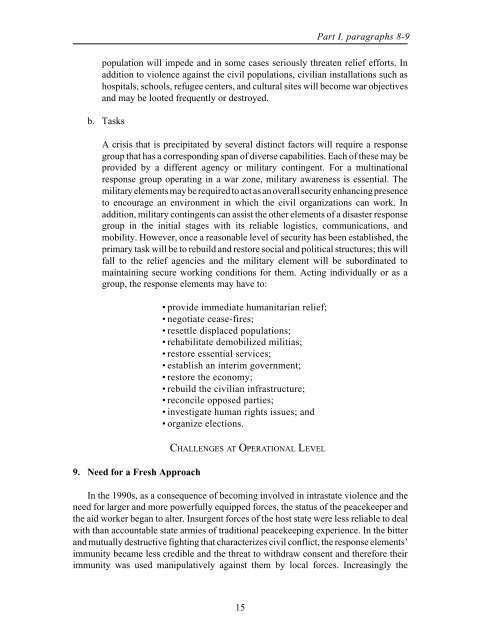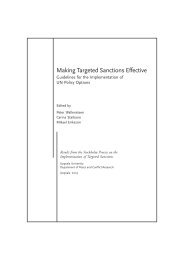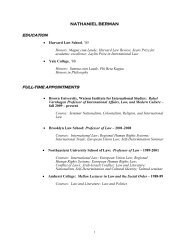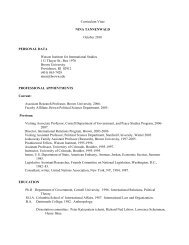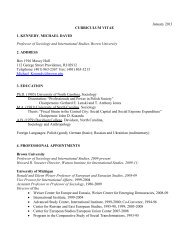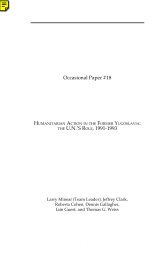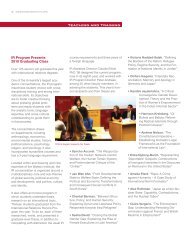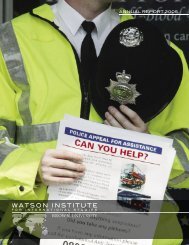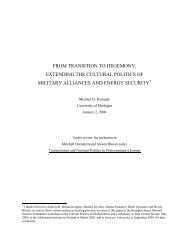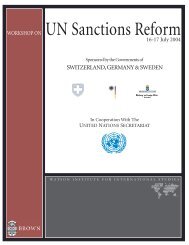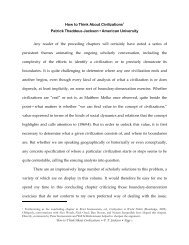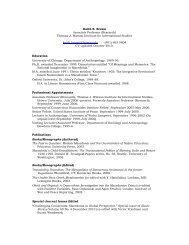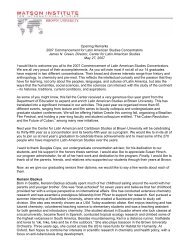- Page 1 and 2: A GUIDE TO PEACE SUPPORT OPERATIONS
- Page 3 and 4: CONTENTS Forword ..................
- Page 5 and 6: FOREWORD The end of the Cold War in
- Page 7 and 8: LIST OF AUTHORS Editor: Dr. John Ma
- Page 9 and 10: Section 4 - Air Force Operations in
- Page 11: Colonel B. Orrell, USAF, National D
- Page 14 and 15: Part I, paragraph 2 c. Security Cou
- Page 16 and 17: Part I, paragraphs 3-4 DEVELOPMENTS
- Page 20 and 21: Part I, paragraphs 9-10 peacekeeper
- Page 22 and 23: Part I, paragraphs 10-11 (3) Popula
- Page 24 and 25: Part I, paragraphs 11-12 Unevenness
- Page 26 and 27: Part I, paragraphs 13-14 constant e
- Page 28 and 29: Part I, paragraphs 14-15 • provid
- Page 30 and 31: Part I, paragraph 16 level may not
- Page 32 and 33: Part I, paragraph 18 description of
- Page 35 and 36: PART II: EMERGENCY RESPONSE, RECOVE
- Page 37 and 38: agencies fail to appreciate that th
- Page 39 and 40: Nongovernmental organizations are i
- Page 41 and 42: humanitarians find themselves in co
- Page 43 and 44: PART II: EMERGENCY RESPONSE, RECOVE
- Page 45 and 46: Part II, Section 2, paragraph 2 Tab
- Page 47 and 48: (2) Assessment Teams and Technical
- Page 49 and 50: Part II, Section 2, paragraph 6 6.
- Page 51 and 52: PART II: EMERGENCY RESPONSE, RECOVE
- Page 53 and 54: Persons who are forced to move or c
- Page 55 and 56: Part II, Section 3, paragraph 4 don
- Page 57 and 58: Part II, Section 3, paragraph 4 (2)
- Page 59 and 60: Part II, Section 3, paragraph 4 pro
- Page 61 and 62: tracking systems are used routinely
- Page 63 and 64: Part II, Section 3, paragraph 5 ass
- Page 65 and 66: tions, the smooth transition from r
- Page 67 and 68: and coordinates the planning and de
- Page 69 and 70:
(1) The World Meteorological Organi
- Page 71 and 72:
In a complex emergency, the residen
- Page 73 and 74:
8. Resources teams are On-Site Oper
- Page 75 and 76:
Information System (INTERFAIS), and
- Page 77 and 78:
curement facilities of UNIPAC are a
- Page 79 and 80:
PART II: EMERGENCY RESPONSE, RECOVE
- Page 81 and 82:
Part II, Section 4, paragraphs 3-5
- Page 83 and 84:
PART II: EMERGENCY RESPONSE, RECOVE
- Page 85 and 86:
followed adequately either chronolo
- Page 87 and 88:
Part II, Section 5, paragraph 5 5.
- Page 89 and 90:
The electoral component also might
- Page 91 and 92:
The provision of accurate and unbia
- Page 93 and 94:
Part II, Section 5, paragraphs 5-7
- Page 95:
Part II, Section 5, paragraph 8 UN
- Page 98 and 99:
Part II, Section 6, paragraphs 2-3
- Page 100 and 101:
Part II, Section 6, paragraphs 3-5
- Page 102 and 103:
Part II, Section 6, paragraph 5 The
- Page 104 and 105:
Part II, Section 6, paragraphs 5-6
- Page 106 and 107:
Part II, Section 6, paragraph 6 •
- Page 108 and 109:
Part II, Section 6, paragraphs 7-8
- Page 110 and 111:
Part II, Section 6, paragraphs 8-9
- Page 112 and 113:
Part II, Section 6, paragraph 9 (3)
- Page 114 and 115:
Part II, Section 6, paragraph 9 (7)
- Page 116 and 117:
Part II, Section 6, paragraph 10 st
- Page 118 and 119:
Part II, Section 6, paragraphs 10-1
- Page 120 and 121:
Part II, Section 6, paragraph 11 In
- Page 122 and 123:
Part II, Section 6, paragraph 11 b.
- Page 124 and 125:
Part II, Section 6 J. Macrae and A.
- Page 126 and 127:
Part II, Section 7, paragraphs 2-3
- Page 128 and 129:
Part II, Section 7, paragraph 4 4.
- Page 130 and 131:
Part II, Section 7, paragraphs 5-6
- Page 132 and 133:
Part II, Section 7, paragraphs 6-7
- Page 134 and 135:
Part II, Section 7, paragraph 9 cie
- Page 136 and 137:
Part II, Section 7 Periodicals: ICR
- Page 138 and 139:
Part II, Section 8, paragraphs 2-3
- Page 140 and 141:
Part II, Section 8, paragraphs 5-6
- Page 142 and 143:
Part II, Section 8, paragraphs 6-7
- Page 144 and 145:
Part III, Section 1, paragraph 2 cl
- Page 146 and 147:
Part III, Section 1, paragraph 2 or
- Page 148 and 149:
Part III, Section 1, paragraphs 2-3
- Page 150 and 151:
Part III, Section 1, paragraphs 3-4
- Page 152 and 153:
Part III, Section 1, paragraph 5 (1
- Page 154 and 155:
Part III, Section 1, paragraph 7 7.
- Page 156 and 157:
Part III, Section 1, paragraph 7 (e
- Page 158 and 159:
Part III, Section 1, paragraph 9 9.
- Page 160 and 161:
Part III, Section 1 Supreme Headqua
- Page 162 and 163:
Part III, Section 2, paragraph 2 PS
- Page 164 and 165:
Part III, Section 2, paragraph 3 3.
- Page 166 and 167:
Part III, Section 2, paragraph 3 di
- Page 168 and 169:
Part III, Section 2, paragraph 3 pa
- Page 170 and 171:
Part III, Section 2, paragraph 3 re
- Page 172 and 173:
Part III, Section 2, paragraphs 3-4
- Page 174 and 175:
Part III, Section 2, paragraph 4 en
- Page 176 and 177:
Part III, Section 2, paragraph 4 Th
- Page 178 and 179:
174
- Page 180 and 181:
Part III, Section 3, paragraph 3 op
- Page 182 and 183:
Part III, Section 3, paragraph 4 ar
- Page 184 and 185:
Part III, Section 3, paragraph 5 Ac
- Page 186 and 187:
Part III, Section 3, paragraph 5 (1
- Page 188 and 189:
Part III, Section 3, paragraph 6 la
- Page 190 and 191:
Part III, Section 3, paragraph 7 th
- Page 192 and 193:
Part III, Section 3, paragraphs 8-9
- Page 194 and 195:
Part III, Section 3, paragraph 9 tr
- Page 196 and 197:
192
- Page 198 and 199:
Part III, Section 4, paragraph 2 qu
- Page 200 and 201:
Part III, Section 4, paragraphs 2-3
- Page 202 and 203:
Part III, Section 4, paragraphs 3-4
- Page 204 and 205:
Part III, Section 4, paragraphs 4-5
- Page 206 and 207:
Part III, Section 4, paragraph 6 (1
- Page 208 and 209:
Part III, Section 4, paragraphs 6-8
- Page 210 and 211:
Part III, Section 4, paragraph 10 a
- Page 212 and 213:
Part III, Section 4, paragraphs 11-
- Page 214 and 215:
Part III, Section 4, paragraph 13 e
- Page 216 and 217:
212
- Page 218 and 219:
Part III, Section 5, paragraphs 3-4
- Page 220 and 221:
Part III, Section 5, paragraphs 5-6
- Page 222 and 223:
Part III, Section 5, paragraphs 7-8
- Page 224 and 225:
220
- Page 226 and 227:
Part IV, Section 1, paragraphs 2-3
- Page 228 and 229:
Part IV, Section 1, paragraph 4 4.
- Page 230 and 231:
Part IV, Section 1, paragraphs 5-6
- Page 232 and 233:
Part IV, Section 1, paragraph 7 d.
- Page 234 and 235:
Part IV, Section 1, paragraph 8 c.
- Page 236 and 237:
Part IV, Section 2, paragraph 2 (1)
- Page 238 and 239:
Part IV, Section 2, paragraph 4 4.
- Page 240 and 241:
Part IV, Section 2, paragraphs 4-5
- Page 242 and 243:
Part IV, Section 2, paragraphs 5-6
- Page 244 and 245:
Part IV, Section 2, paragraph 7 As
- Page 246 and 247:
Part IV, Section 2, paragraph 8 Fig
- Page 248 and 249:
244
- Page 250 and 251:
ANNEX 2 DEPARTMENT OF POLITICAL AFF
- Page 252 and 253:
ANNEX 4 DEPARTMENT OF HUMANITARIAN
- Page 254 and 255:
ANNEX 6 CODE OF CONDUCT FOR THE INT
- Page 256 and 257:
THE CODE OF CONDUCT Principles of C
- Page 258 and 259:
8. Relief aid must strive to reduce
- Page 260 and 261:
Equally, governments should not res
- Page 262 and 263:
ANNEX 7 Article 1 UNITED NATIONS CO
- Page 264 and 265:
Article 5 1 No law enforcement may
- Page 266 and 267:
Commentary a. This Code shall be ob
- Page 268 and 269:
ERC EU FACs FALD FAO FINNIDA FSO GI
- Page 270:
VSTOL WEU WFP WFPA WHO WMO WVI vert


